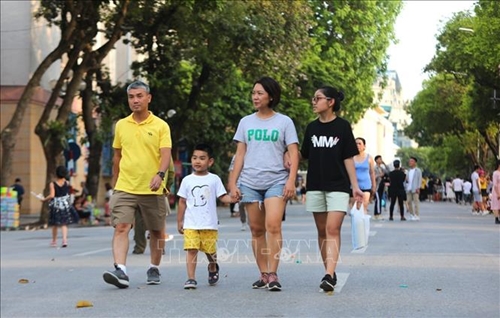Based on forecasts and Hanoi’s socio-economic development scenarios to counter the COVID-19 pandemic, the city will give priority to the recovery of the domestic tourism.
Accordingly, some tourist destinations in the city have lowered ticket fees or presented gifts to attract more visitors.
    |
 |
|
Hanoi aims to receive 11 million domestic tourists in H2. (Photo for illustration) |
The Department of Tourism said it will focus on tourism products which Hanoi boasts strengths in, such as heritage tourism, ecotourism and agro-tourism when COVID-19 is brought under control.
The sector will also work to further promote the city’s image as a safe, friendly, and civilized destination, and improve human resources quality.
Night-time economy is expected to help develop Hanoi tourism, according to tourism experts and policymakers.
The Hanoi Old Quarter, located in the downtown in Hoan Kiem district, is the most popular destination in the capital city. Tourists come here to explore ancient streets, craft products, local food, or experience lives there. In the evening, streets become more crowded and lively with Hang Dao – Dong Xuan night fair and outdoor music performances.
Since 2016, Hanoi has allowed Hoan Kiem district to pilot the extension of opening hour of bars and restaurants to 2 a.m. As a result, their revenues increased by about 30 percent.
Following the pilot, tourist arrivals in 2016 neared 1.4 million, up 22.8 percent from a year earlier. The figure went up to 1.95 million in 2017, nearly 2.2 million in 2018, and 2.5 million in 2019.
Between January and May 2020, Hanoi’s tourism sector earned over 16.6 trillion VND (715 million USD), a deep reduction compared to the same period last year. However, it was still an encouraging figure, as both the national and global economies have been adversely impacted by the pandemic.
There are 3,499 tourist accommodation facilities with 60,782 rooms in Hanoi. Among them, 66 hotels with 9,953 rooms have three- to five-star ratings, and eight condotels with 1,534 rooms have four- or five-star ratings.
According to the Vietnam National Administration of Tourism, foreign tourist arrivals to Vietnam in the first five months of this year totaled 3.7 million while the number of domestic holidaymakers stood at 16 million, down 50 percent and 58.5 percent, respectively, from the same period last year.
The capital city last year welcomed nearly 29 million tourists, up 10.1 percent year-on-year, more than 7 million of them foreign guests, increasing by 17 percent.
In recent years, Hanoi has been hailed as one of the most attractive destinations in the region and the world by prestigious international organizations such as “Asia’s Leading Destination” and the “World’s Leading Destination” in 2018.
In 2019, Hanoi won the Travelers’ Choice Awards and was ranked among the 25 leading destinations in Asia, and the 25 world’s leading places on TripAdvisor website.
CNN listed Hanoi along with Phu Quoc Island in the Mekong Delta province of Kien Giang as the best travel destinations in Asia in 2019.
Many highlights of Hanoi were recently listed in the CNN’s article suggesting 13 memorable experiences for foreign visitors in Vietnam such as “search for the best pho in Hanoi,” “make vermicelli noodles in Cu Da village,” and “ride the Reunification Express (officially known as North-South Railway).”
Hanoi ranked fifth among the seven best places in Asia for solo travelers by Bigseventravel.
The Italian tourism website described Hanoi as a hectic, crazy and often confusing city, and a wonderful base from which to explore the north of Vietnam, including the world natural heritage site of Ha Long Bay in the northeastern province of Quang Ninh and the popular resort town of Sa Pa in the Northern mountainous province of Lao Cai.
According to Mastercard’s Asia Pacific Destinations Index, Hanoi ranked 15th among the 20 leading destinations in the region.
Source: VNA